Abstract
1. Experiments were carried out to establish what relationship there is between the concentration of ketone bodies in the blood and the concentrations of glycogen in muscle and liver of thirty-six trained and thirty-six untrained rats exercised at the same absolute load. There were, in addition, non-exercised control animals (of which thirty-six were trained and thirty-six untrained) which were studied on the same day. 2. Training occurred on a level treadmill at 0.2 m/s for 1 h/day, 5 days a week, for 6 weeks. The untrained animals ran on the treadmill every 3rd day for 5 min to maintain familiarity with treadmill running without training them. 3. At the end of the 6th week, the experimental animals ran for 1 h at 0.2 m/s on a level treadmill. Blood 3-hydroxybutyrate and tissue glycogen concentrations were measured at the beginning and immediately after exercise, and then every 30 min for 2 h. 4. Physically trained rats had higher pre- and immediate post-exercise liver glycogen concentrations than untrained rats: 413 +/- 15 and 300 +/- 8 mumol/g before exercise in trained and untrained rats respectively, and 225 +/- 8 and 166 +/- 3 mumol/g immediately after (P less than 0.05). 5. Muscle glycogen, which was also higher in trained than in untrained rats, was resynthesized at approximately the same rate in the two groups of animals (9 and 11 mumol/(g h), but the trained animals were able to achieve this without further depletion of liver glycogen beyond that which had occurred during exercise. In untrained animals liver glycogen concentrations continued to drop for 60 min beyond the end of exercise.(ABSTRACT TRUNCATED AT 250 WORDS)
Full text
PDF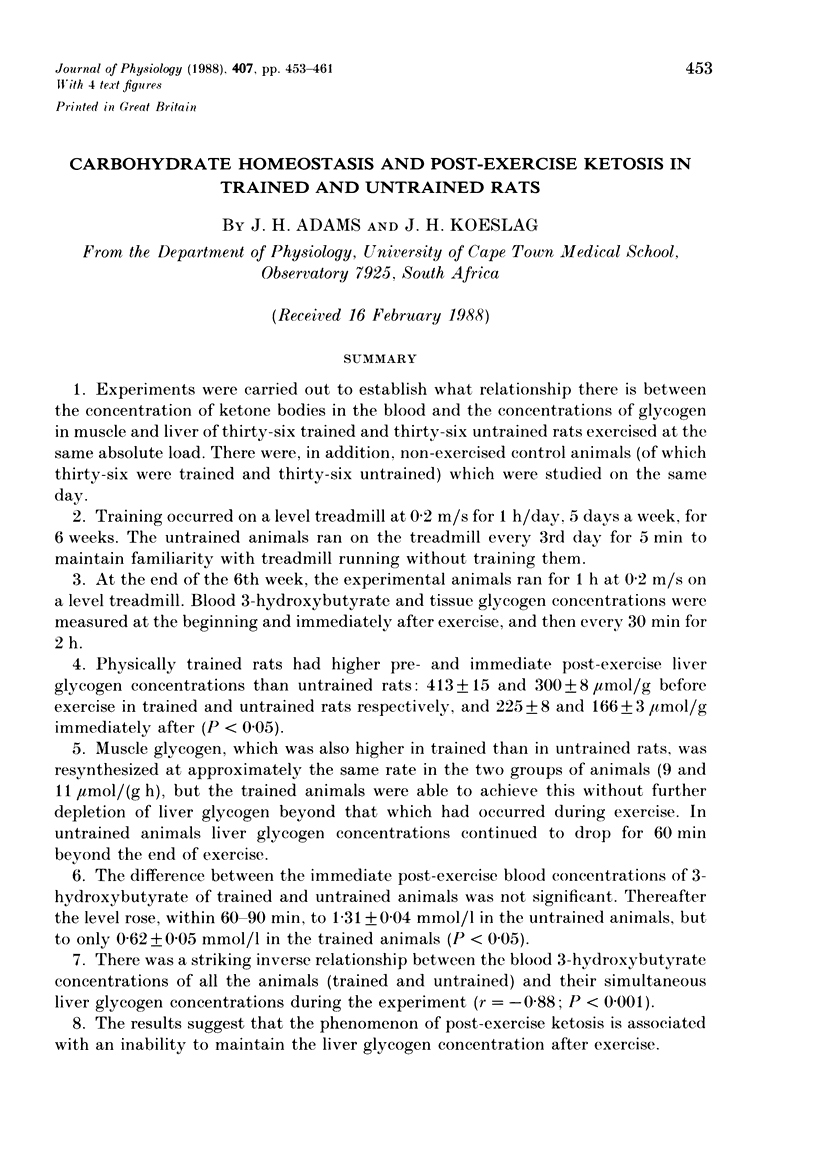
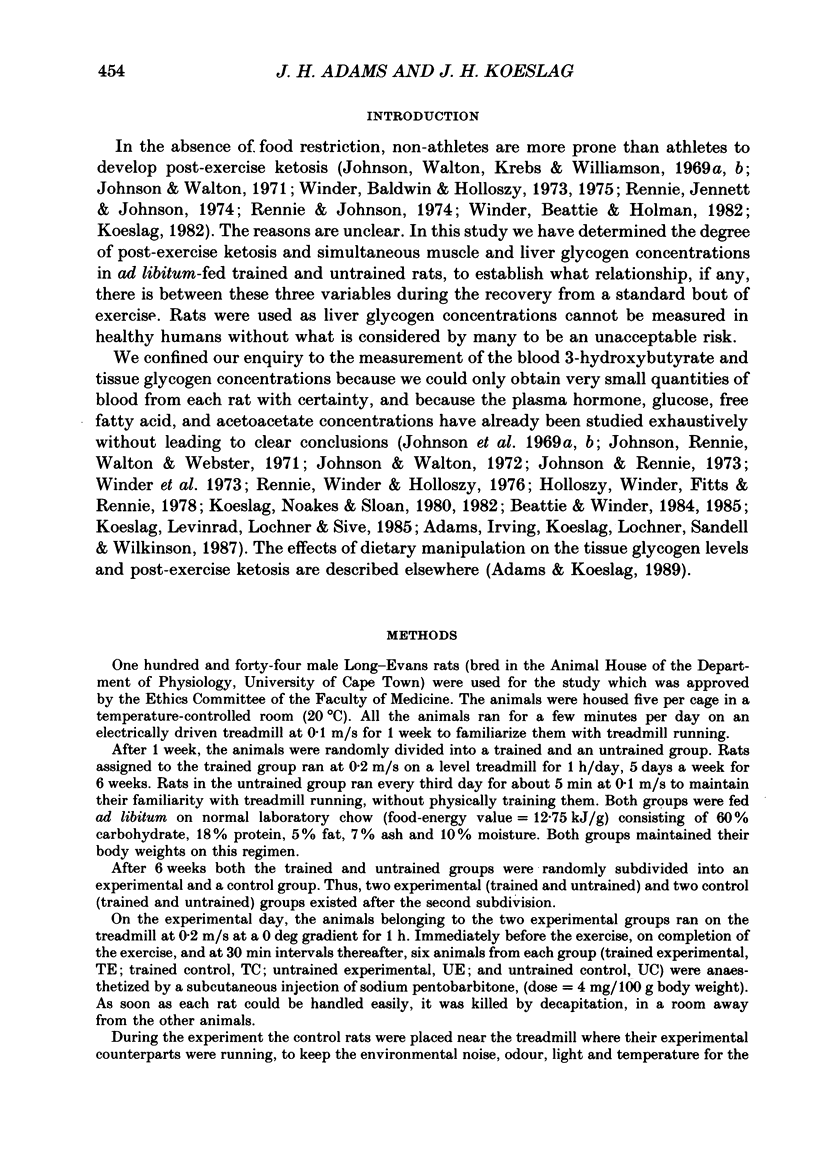
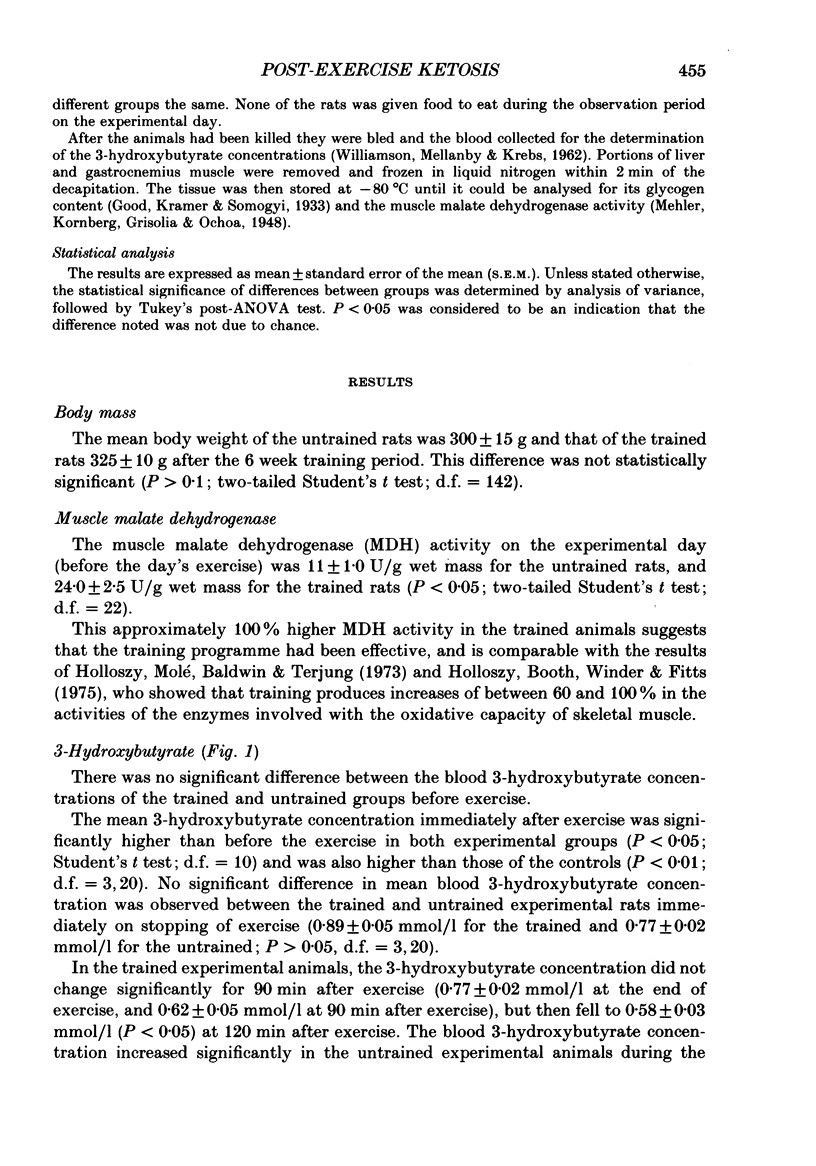
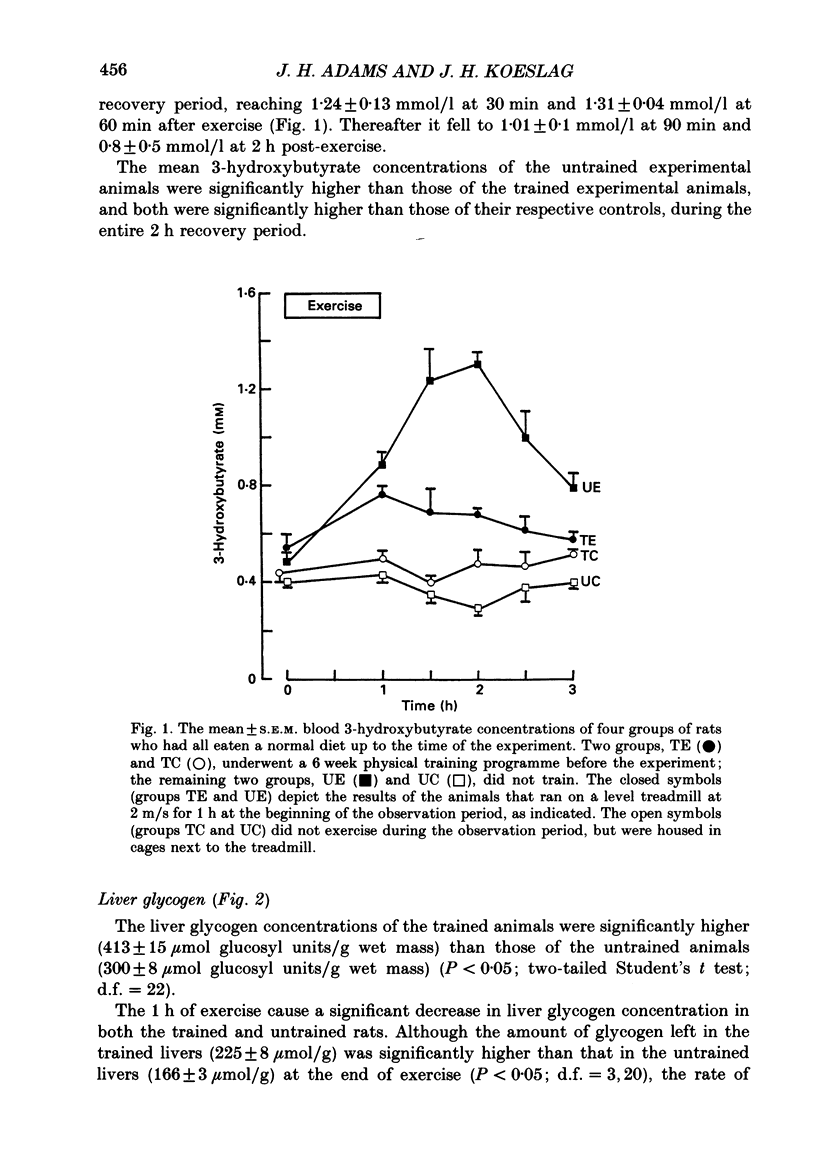
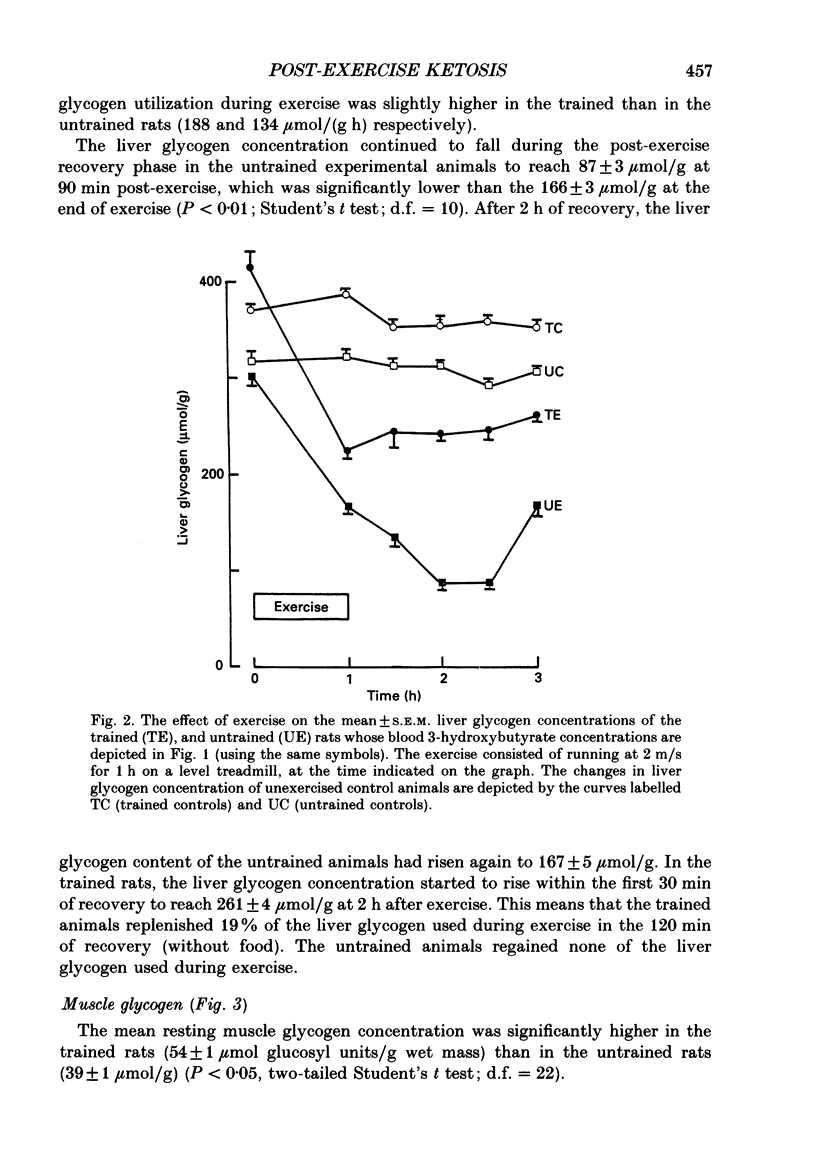
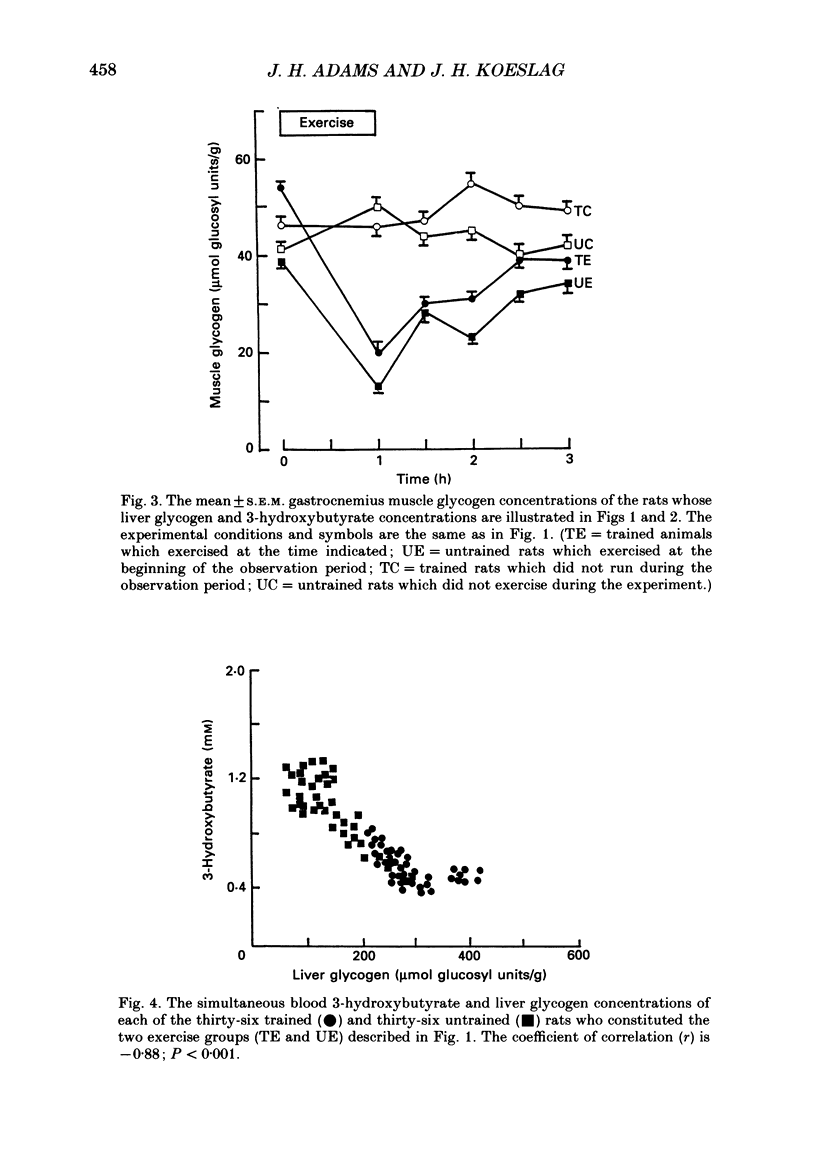
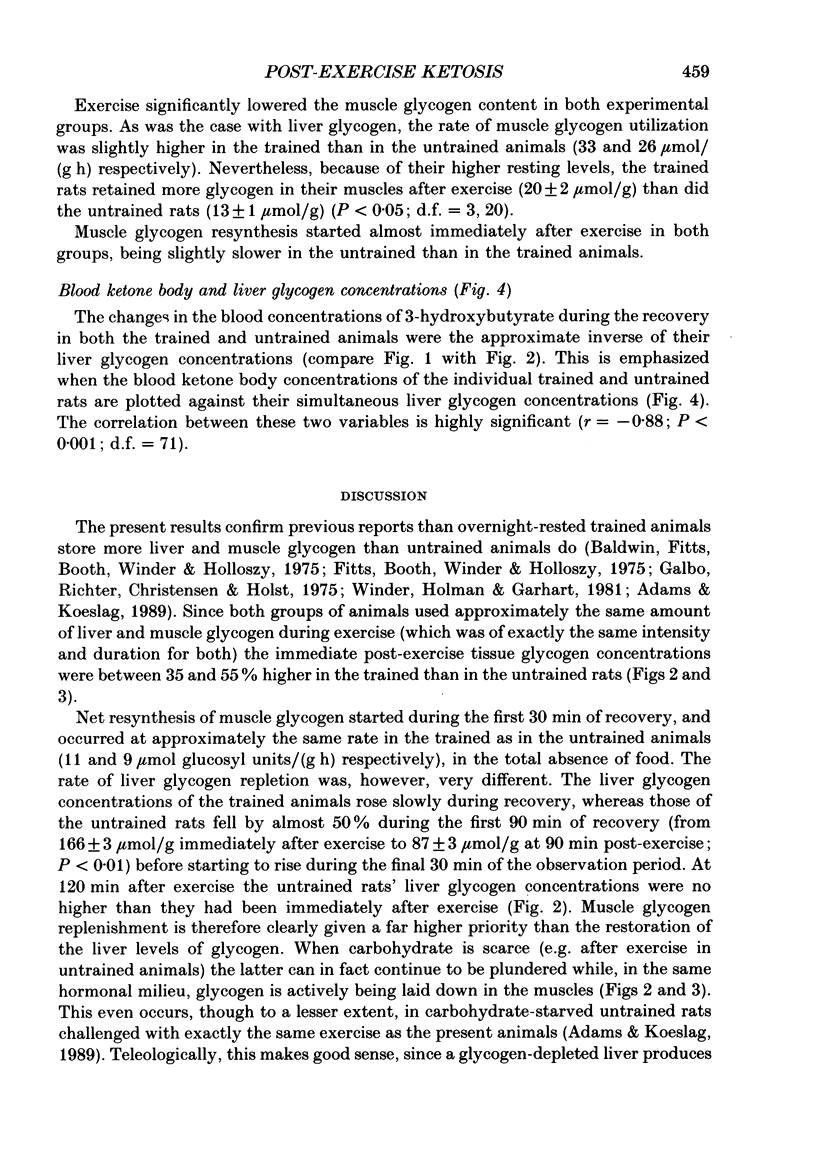
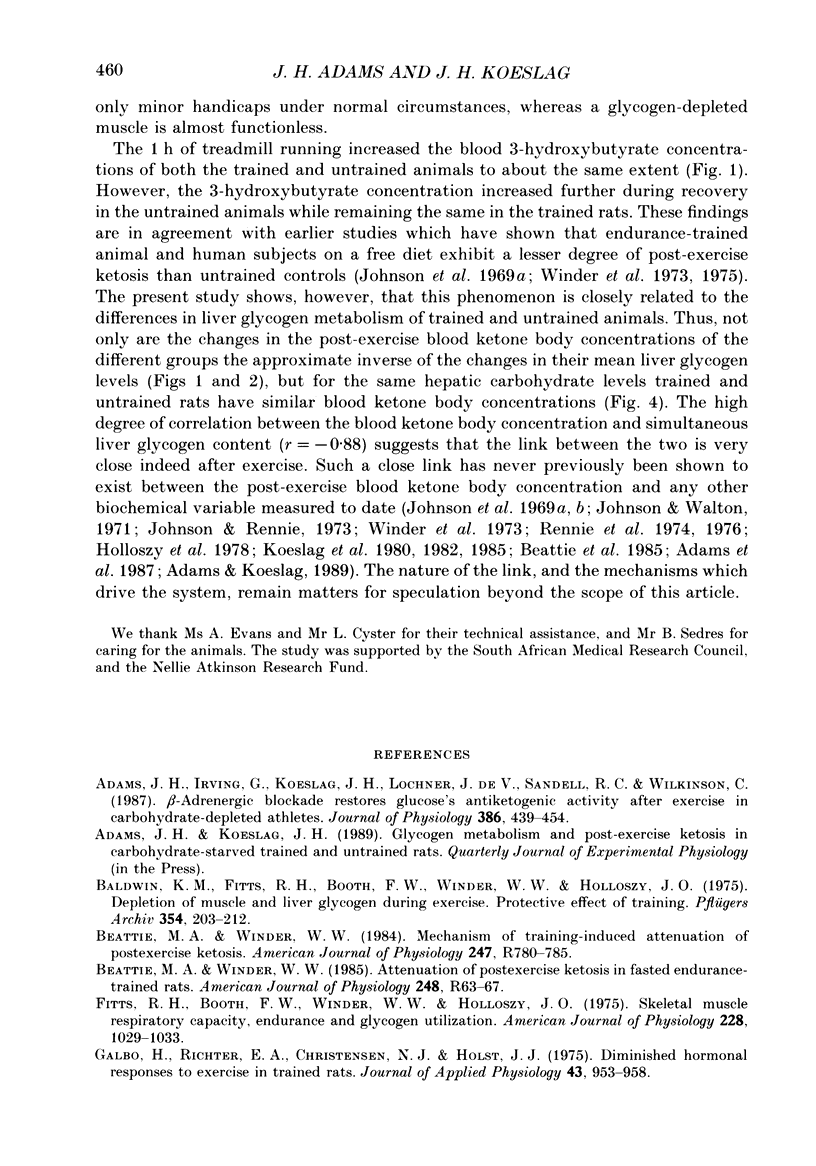
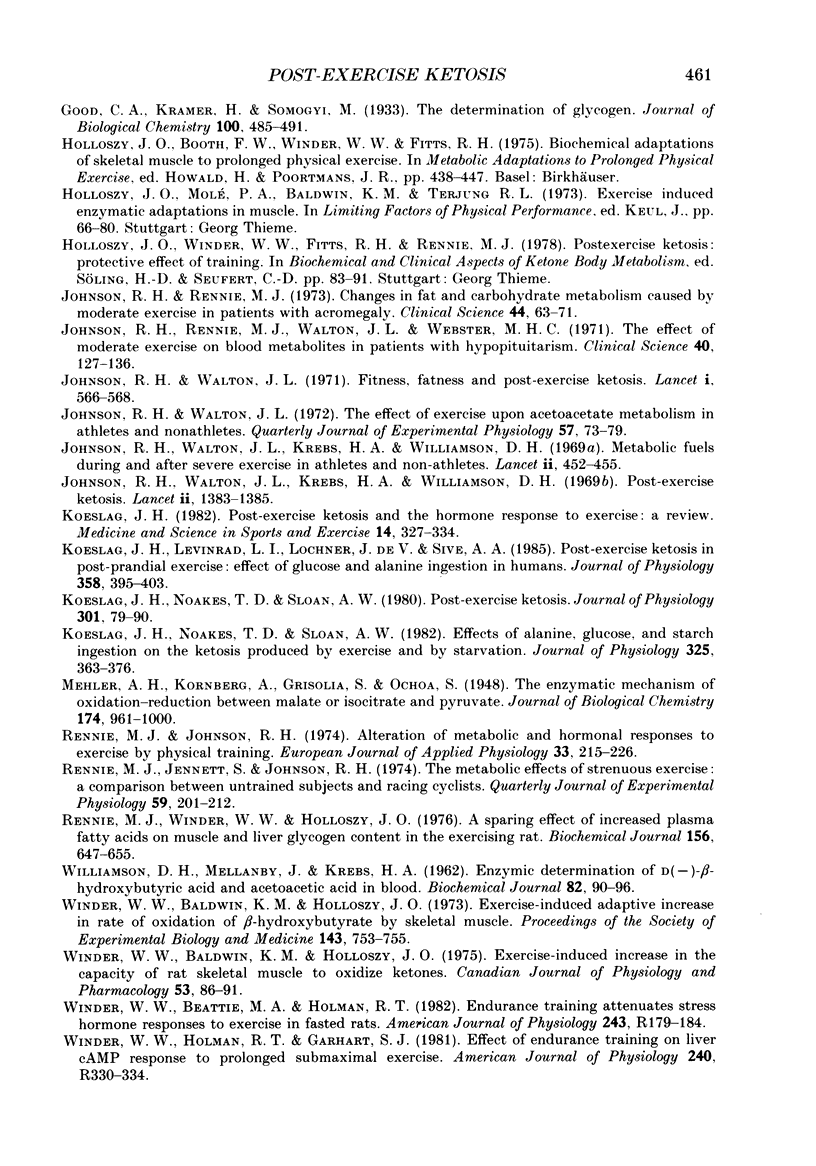
Selected References
These references are in PubMed. This may not be the complete list of references from this article.
- Adams J. H., Irving G., Koeslag J. H., Lochner J. D., Sandell R. C., Wilkinson C. Beta-adrenergic blockade restores glucose's antiketogenic activity after exercise in carbohydrate-depleted athletes. J Physiol. 1987 May;386:439–454. doi: 10.1113/jphysiol.1987.sp016543. [DOI] [PMC free article] [PubMed] [Google Scholar]
- Baldwin K. M., Fitts R. H., Booth F. W., Winder W. W., Holloszy J. O. Depletion of muscle and liver glycogen during exercise. Protective effect of training. Pflugers Arch. 1975;354(3):203–212. doi: 10.1007/BF00584644. [DOI] [PubMed] [Google Scholar]
- Beattie M. A., Winder W. W. Mechanism of training-induced attenuation of postexercise ketosis. Am J Physiol. 1984 Nov;247(5 Pt 2):R780–R785. doi: 10.1152/ajpregu.1984.247.5.R780. [DOI] [PubMed] [Google Scholar]
- Fitts R. H., Booth F. W., Winder W. W., Holloszy J. O. Skeletal muscle respiratory capacity, endurance, and glycogen utilization. Am J Physiol. 1975 Apr;228(4):1029–1033. doi: 10.1152/ajplegacy.1975.228.4.1029. [DOI] [PubMed] [Google Scholar]
- Galbo H., Richter E. A., Holst J. J., Christensen N. J. Diminished hormonal responses to exercise in trained rats. J Appl Physiol Respir Environ Exerc Physiol. 1977 Dec;43(6):953–958. doi: 10.1152/jappl.1977.43.6.953. [DOI] [PubMed] [Google Scholar]
- Johnson R. H., Rennie M. J. Changes in fat and carbohydrate metabolism caused by moderate exercise in patients with acromegaly. Clin Sci. 1973 Jan;44(1):63–71. doi: 10.1042/cs0440063. [DOI] [PubMed] [Google Scholar]
- Johnson R. H., Rennie M. J., Walton J. L., Webster M. H. The effect of moderate exercise on blood metabolites in patients with hypopituitarism. Clin Sci. 1971 Feb;40(2):127–136. doi: 10.1042/cs0400127. [DOI] [PubMed] [Google Scholar]
- Johnson R. H., Walton J. L. Fitness, fatness, and post-exercise ketosis. Lancet. 1971 Mar 20;1(7699):566–568. doi: 10.1016/s0140-6736(71)91164-0. [DOI] [PubMed] [Google Scholar]
- Johnson R. H., Walton J. L., Krebs H. A., Williamson D. H. Metabolic fuels during and after severe exercise in athletes and non-athletes. Lancet. 1969 Aug 30;2(7618):452–455. doi: 10.1016/s0140-6736(69)90164-0. [DOI] [PubMed] [Google Scholar]
- Johnson R. H., Walton J. L., Krebs H. A., Williamson D. H. Post-exercise ketosis. Lancet. 1969 Dec 27;2(7635):1383–1385. doi: 10.1016/s0140-6736(69)90931-3. [DOI] [PubMed] [Google Scholar]
- Johnson R. H., Walton J. L. The effect of exercise upon acetoacetate metabolism in athletes and non-athletes. Q J Exp Physiol Cogn Med Sci. 1972 Jan;57(1):73–79. doi: 10.1113/expphysiol.1972.sp002139. [DOI] [PubMed] [Google Scholar]
- Koeslag J. H., Levinrad L. I., Lochner J. D., Sive A. A. Post-exercise ketosis in post-prandial exercise: effect of glucose and alanine ingestion in humans. J Physiol. 1985 Jan;358:395–403. doi: 10.1113/jphysiol.1985.sp015557. [DOI] [PMC free article] [PubMed] [Google Scholar]
- Koeslag J. H., Noakes T. D., Sloan A. W. Post-exercise ketosis. J Physiol. 1980 Apr;301:79–90. doi: 10.1113/jphysiol.1980.sp013190. [DOI] [PMC free article] [PubMed] [Google Scholar]
- Koeslag J. H., Noakes T. D., Sloan A. W. The effects of alanine, glucose and starch ingestion on the ketosis produced by exercise and by starvation. J Physiol. 1982 Apr;325:363–376. doi: 10.1113/jphysiol.1982.sp014155. [DOI] [PMC free article] [PubMed] [Google Scholar]
- Koeslag J. H. Post-exercise ketosis and the hormone response to exercise: a review. Med Sci Sports Exerc. 1982;14(5):327–334. [PubMed] [Google Scholar]
- Rennie M. J., Jennett S., Johnson R. H. The metabolic effects of strenuous exercise: a comparison between untrained subjects and racing cyclists. Q J Exp Physiol Cogn Med Sci. 1974 Jul;59(3):201–212. doi: 10.1113/expphysiol.1974.sp002262. [DOI] [PubMed] [Google Scholar]
- Rennie M. J., Johnson R. H. Alteration of metabolic and hormonal responses to exercise by physical training. Eur J Appl Physiol Occup Physiol. 1974;33(3):215–226. doi: 10.1007/BF00421149. [DOI] [PubMed] [Google Scholar]
- Rennie M. J., Winder W. W., Holloszy J. O. A sparing effect of increased plasma fatty acids on muscle and liver glycogen content in the exercising rat. Biochem J. 1976 Jun 15;156(3):647–655. doi: 10.1042/bj1560647. [DOI] [PMC free article] [PubMed] [Google Scholar]
- WILLIAMSON D. H., MELLANBY J., KREBS H. A. Enzymic determination of D(-)-beta-hydroxybutyric acid and acetoacetic acid in blood. Biochem J. 1962 Jan;82:90–96. doi: 10.1042/bj0820090. [DOI] [PMC free article] [PubMed] [Google Scholar]
- Winder W. W., Baldwin K. M., Holloszy J. O. Exercise-induced adaptive increase in rate of oxidation of beta-hydroxybutyrate by skeletal muscle. Proc Soc Exp Biol Med. 1973 Jul;143(3):753–755. doi: 10.3181/00379727-143-37406. [DOI] [PubMed] [Google Scholar]
- Winder W. W., Baldwin K. M., Holloszy J. O. Exercise-induced increase in the capacity of rat skeletal muscle to oxidize ketones. Can J Physiol Pharmacol. 1975 Feb;53(1):86–91. doi: 10.1139/y75-011. [DOI] [PubMed] [Google Scholar]
- Winder W. W., Beattie M. A., Holman R. T. Endurance training attenuates stress hormone responses to exercise in fasted rats. Am J Physiol. 1982 Jul;243(1):R179–R184. doi: 10.1152/ajpregu.1982.243.1.R179. [DOI] [PubMed] [Google Scholar]
- Winder W. W., Holman R. T., Garhart S. J. Effect of endurance training on liver cAMP response to prolonged submaximal exercise. Am J Physiol. 1981 May;240(5):R330–R334. doi: 10.1152/ajpregu.1981.240.5.R330. [DOI] [PubMed] [Google Scholar]


